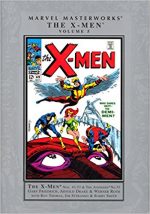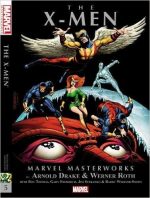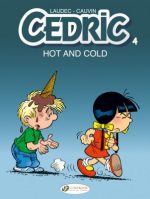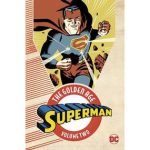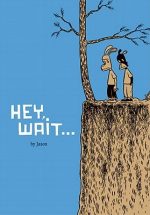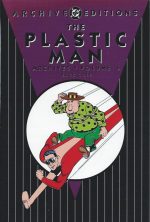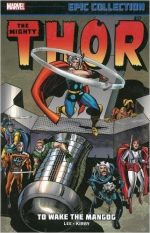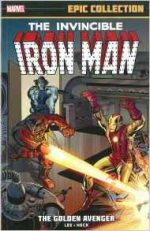
By Stan Lee, Larry Lieber, Robert Bernstein, Al Hartley, Don Heck, Jack Kirby, Steve Ditko & various (Marvel)
ISBN: 978-0-7851-8863-6
There are a number of ways to interpret the creation and early years of Tony Stark, glamorous millionaire industrialist and inventor – not to mention his armoured alter-ego, Iron Man.
Created in the immediate aftermath of the Cuban Missile Crisis and at a time when “Red-baiting†and “Commie-bashing†were American national obsessions, the emergence of a brilliant new Thomas Edison, using Yankee ingenuity and invention to safeguard and better the World, seemed inevitable. Combine the then-all-pervasive belief that technology could solve any problem with the universal imagery of noble knights battling evil and the proposition almost becomes a certainty.
Of course, it might simply be that us kids thought it both great fun and very, very cool…
This fabulous full-colour compendium of the Steel Shod Sentinel’s early days reprints all his adventures, feature pages and pin-ups from Tales of Suspense #39 (cover-dated March 1963) through #72 (December 1965); revisiting the dawn of Marvel’s renaissance.
This period would see them start to challenge DC Comics position of dominance, but not quite become the darlings of the student counter-culture. In these tales, Tony Stark is still very much the gung-ho patriotic armaments manufacturer, and not the enlightened capitalist liberal dissenter he would become.
ToS #39, with a script by Larry Lieber (over brother Stan Lee’s plot) and art by the criminally unappreciated Don Heck reveals how and why ‘Iron Man is Born’, with electronics genius Stark field-testing his latest inventions in Viet Nam when he is wounded by a landmine.
Captured by Viet Cong commander Wong-Chu, Stark is told that if he creates weapons for the Reds he will be operated on to remove the metal shrapnel in his chest that will kill him within seven days.
Knowing that Commies can’t be trusted, Stark and aged Professor Yinsen – another captive scientist – build a mobile iron lung to keep his heart beating. They also equip this suit of armour with all the weapons that their ingenuity can secretly build whilst being observed by their captors. Naturally they succeed and defeat Wong-Chu, but not without tragic sacrifice.
From the next issue, Iron Man’s superhero career is taken as a given, and he has already achieved fame for largely off-camera exploits. Lee continues to plot but Robert Bernstein replaces Lieber as scripter for issues #40-46 and Jack Kirby shares the pencilling chores with Heck. ‘Iron Man versus Gargantus’ follows the young Marvel pattern by pitting the hero against aliens – albeit via their robotic giant caveman intermediary, in a delightfully rollicking romp pencilled by Kirby and inked by Heck.
‘The Stronghold of Doctor Strange’ (art by Kirby & Dick Ayers) features a gloriously spectacular confrontation with a wizard of Science (not Lee/Ditko’s later Mystic Master), and Heck returns to full art for the espionage and impostors thriller ‘Trapped by the Red Barbarian’.
Kirby and Heck team again for the science-fantasy adventure ‘Kala, Queen of the Netherworld!’, but Heck goes it alone when Iron Man time-travels to ancient Egypt to rescue the fabled and fabulous Cleopatra from ‘The Mad Pharaoh!’. New regular cast members – bodyguard “Happy Hogan†and secretary Virginia “Pepper†Potts – proper and the first true super-villain then arrive as the Steel Sentinel has to withstand ‘The Icy Fingers of Jack Frost!’ before facing (and converting to Democracy) his Soviet counterpart ‘The Crimson Dynamo’.
Tales of Suspense #47 presaged big changes. Stan Lee wrote ‘Iron Man Battles the Melter!‘, and Heck inked over the unique pencils of Steve Ditko, but the big event came with the next issue’s ‘The Mysterious Mr. Doll!’ as Lee, Ditko & Ayers scrapped the old cool-but-clunky golden boiler-plate suit for a sleek, gleaming, form-fitting, red-and-gold upgrade that would – with minor variations – become the symbol and trademark of the character for decades.
Paul Reinman inked Ditko on Lee’s crossover/sales pitch for the new X-Men comic when ‘Iron Man Meets the Angel!’, but the series only really takes hold with Tales of Suspense #50.
Don Heck became regular penciller and occasional inker and Lee concocted the Armoured Avenger’s first major menace and perpetual nemesis with ‘The Hands of the Mandarin’; a modern Fu Manchu derivative who terrifies the Red Chinese so much that they manipulate him into attacking America, with the hope that one threat will fatally wound the other. The Mandarin would become Iron Man’s greatest foe.
Our hero made short work of criminal contortionist ‘The Sinister Scarecrow’, and the Red spy who appropriated that leftover Russian armour-suit and declared ‘The Crimson Dynamo Strikes Again!’ (scripted, as was the next issue, by the enigmatic “N. Kurokâ€). The issue also premiered a far more dangerous threat in the slinky shape of Soviet Femme Fatale the Black Widow.
With ToS#53, she was a headliner as ‘The Black Widow Strikes Again!’: stealing Stark’s new anti-gravity ray but ultimately failing in her sabotage mission after which ‘The Mandarin’s Revenge!’ began a two-part tale of kidnap and coercion that concluded with #55’s ‘No One Escapes the Mandarin!’
‘The Uncanny Unicorn!’ promptly attacked after actually Iron Man did, only to fare no better in the end. The power-horn peril was preceded in his attempt to destroy the Armoured Avenger by a cascade of short of Lee/Heck illustrated fact features beginning with ‘All About Iron Man’, continuing with ‘More Info About Iron Man!’ and concluding with a ‘Pepper Potts Pin-up Page’.
Black Widow resurfaced to beguile budding superhero ‘Hawkeye, The Marksman!’ into attacking the Golden Avenger in #57, before another landmark occurred with the next issue. Until now Iron Man had monopolised Tales of Suspense, but ‘In Mortal Combat with Captain America’ (inked by Ayers) depicted an all-out battle between the two heroes resulting from a clever impersonation by evil impressionist The Chameleon. It was a primer for the next issue when Cap would begin his own solo adventures, splitting the monthly comic into an anthology featuring Marvel’s top two patriotic paladins.
Iron Man’s initial half-length outing in #59 was against the technological terror ‘The Black Knight!’, and as a result Stark was rendered unable to remove his own armour without triggering a heart attack: a situation that hadn’t occurred since the initial injury. Up until this time he had led a relatively normal life by simply wearing the life-sustaining breast-plate under his clothes. The introduction of soap-opera sub-plots were a necessity of the shorter page counts, as were continued stories, but this seeming disadvantage worked to improve both the writing and the sales.
With Stark’s “disappearance,†Iron Man was ‘Suspected of Murder!’, a tale that featured the return of Hawkeye and Black Widow (abruptly transformed from fur-clad seductress into a gadget-laden costumed villain), and led directly into ‘The Death of Tony Stark!’ and ‘The Origin of the Mandarin!’. After that extended epic, a change of pace occurred as short complete exploits returned.
The first was #63’s industrial sabotage thriller ‘Somewhere Lurks the Phantom!’, followed by the somewhat self-explanatory ‘Hawkeye and the New Black Widow Strike Again!’ (inked by Chic Stone), after which ‘When Titans Clash!’ saw a burglar steal the new armour forcing Stark to defeat his greatest invention with his old suit (inked by new regular Mike Esposito under the pseudonym Mickey DeMeo).
Sub-sea villain Attuma is the threat du jour in ‘If I Fail a World is Lost’ and crime-lord Count Nefaria uses dreams as a weapon in ‘Where Walk the Villains!’, returning in the next issue to attack Stark with hallucinations in ‘If a Man be Mad!’, a rather weak tale that introduces Stark’s ne’er-do-well cousin Morgan, (written by Al Hartley with Heck and Esposito in top form as always).
Issues #69-71 form another continued saga, and one of the best of this early period. ‘If I Must Die, Let It Be with Honor!’ (inked by Vince Colletta) sees Iron Man forced to duel a new Russian opponent called the Titanium Man in a globally-televised contest that both super-powers see as a vital propaganda coup. The governments are naturally quite oblivious of the cost to the participants and their friends…
 ‘Fight On! For a World is Watching!’ (DeMeo inks) amplifies the intrigue and tension as the Soviets, caught cheating, pile on the pressure to at least kill the American champion if they can’t score a publicity win, and final chapter ‘What Price Victory?’ is a rousing, emotional conclusion of triumph and tragedy made magnificent by the super-glossy inking of troubled artistic genius Wally Wood.
That would have been the ideal place to end the volume but there’s one more episode included here: ToS #72 by Lee, Heck & Demeo deals with the aftermath of victory as, whilst the fickle public fête Iron Man, his best friend lies dying, and a spiteful ex-lover hires the Mad Thinker to destroy Stark and his company forever. ‘Hoorah for the Conquering Hero!’ closes the book on a pensive down-note, but the quality of this compendium package is undeniable. From broad comedy and simple action to dark cynicism and relentless battle, Marvel Comics grew up with this deeply contemporary series.
Iron Man developed amidst the growing political awareness of the Viet Nam Generation who were the comic’s maturing readership. Wedded as it was to the American Industrial-Military Complex, with a hero – originally the government’s wide-eyed golden boy – gradually becoming attuned to his country’s growing divisions, it was, as much as Spider-Man, a bellwether of the times. That it remains such a thrilling uncomplicated romp of classic super-hero fun is a lasting tribute to the talents of all those superb creators that worked it.
© 1963, 1964, 1965, 2014 Marvel Characters, Inc. All rights reserved.


